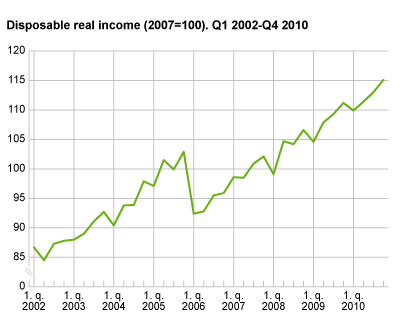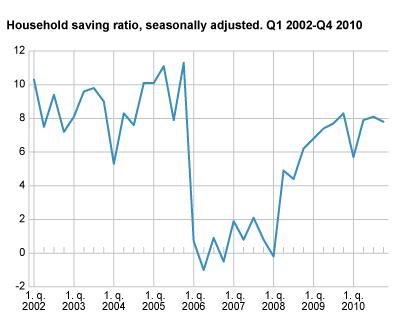Content
Published:
This is an archived release.
Continued increase in disposable real income
Households’ disposable income increased from the 3rd to 4th quarter, according to seasonally-adjusted figures. The growth was steady through 2010, and disposable income was in total 5.8 per cent higher in 2010 than in 2009. This gave an increase in of 3.8 per cent in disposable real income.
Compensation of employees, which is the most important source of income in the household sector, went up approximately 4 per cent in 2010, nominally measured, and accounted for nearly half of the increase in disposable real income. The increase in compensation of employees was stronger in the second half of 2010 than in the first, and from the 3rd to 4th quarter the growth was 1.6 per cent.
Payments and benefits from general government went up by 5.5 per cent from 2009 to 2010. This increase contributed to pulling the growth in disposable real income up by 1.1 percentage points. Seasonally-adjusted figures show that the increase was steady through the 2010. It was in particular retirement and unemployment benefits that pulled the payments from general government up. Sickness and disability payments showed a slight decrease in 2010.
Property income received, which mainly consists of income from interest and dividends, increased by 7.7 per cent in 2010. Property income paid decreased by 1.5 per cent. From the 3rd to 4th quarter property income received went up by 2.1 per cent, while property income paid remained almost unchanged.
Saving rate unchanged from 2009
In 2010, households’ saving amounted to approximately NOK 82.9 billion, which is NOK 2.6 billion more than in 2009. Savings’ share of disposable income, the saving rate, is measured to be 7.4 per cent in 2010, compared to 7.5 in 2009. Seasonally-adjusted figures show that households’ saving was higher in the two last quarters of the year that in the first two.
| 2008* | 2009* | 2010* | Real growth. Percentage2 | Contribution to growth on disposable real income. Percentage points | |||||||||||||||||||||||||||||||||||||||||||||||||||||||||||||||||||||||||||
|---|---|---|---|---|---|---|---|---|---|---|---|---|---|---|---|---|---|---|---|---|---|---|---|---|---|---|---|---|---|---|---|---|---|---|---|---|---|---|---|---|---|---|---|---|---|---|---|---|---|---|---|---|---|---|---|---|---|---|---|---|---|---|---|---|---|---|---|---|---|---|---|---|---|---|---|---|---|---|---|
| 2008* | 2009* | 2010* | 2008* | 2009* | 2010* | ||||||||||||||||||||||||||||||||||||||||||||||||||||||||||||||||||||||||||
| Income | 1 460.1 | 1 505.0 | 1 578.9 | 5.2 | 0.5 | 2.9 | 7.6 | 0.8 | 4.1 | ||||||||||||||||||||||||||||||||||||||||||||||||||||||||||||||||||||||
| Compensation of employees | 857.0 | 884.0 | 919.6 | 5.3 | 0.6 | 2.0 | 4.5 | 0.5 | 1.7 | ||||||||||||||||||||||||||||||||||||||||||||||||||||||||||||||||||||||
| Mixed income | 110.9 | 112.5 | 121.0 | -1.3 | -1.0 | 5.5 | -0.2 | -0.1 | 0.6 | ||||||||||||||||||||||||||||||||||||||||||||||||||||||||||||||||||||||
| Property income received | 96.7 | 72.1 | 77.7 | 16.3 | -27.2 | 5.6 | 1.4 | -2.6 | 0.4 | ||||||||||||||||||||||||||||||||||||||||||||||||||||||||||||||||||||||
| Amount of which is due to dividends | 26.5 | 24.8 | 27.9 | 38.3 | -8.7 | 10.1 | 0.8 | -0.2 | 0.2 | ||||||||||||||||||||||||||||||||||||||||||||||||||||||||||||||||||||||
| Pensions and benefits from general government | 298.3 | 326.5 | 344.4 | 3.5 | 6.8 | 3.5 | 1.1 | 2.0 | 1.1 | ||||||||||||||||||||||||||||||||||||||||||||||||||||||||||||||||||||||
| Other income (net) | 56.2 | 60.9 | 65.5 | -0.3 | 5.6 | 5.6 | 0.0 | 0.3 | 0.3 | ||||||||||||||||||||||||||||||||||||||||||||||||||||||||||||||||||||||
| Correction for FISIM | 41.0 | 48.9 | 50.6 | 21.0 | 16.6 | 1.5 | 0.7 | 0.7 | 0.1 | ||||||||||||||||||||||||||||||||||||||||||||||||||||||||||||||||||||||
| Expenditures | 466.7 | 441.1 | 453.6 | 8.9 | -7.8 | 0.9 | -4.0 | 3.7 | -0.4 | ||||||||||||||||||||||||||||||||||||||||||||||||||||||||||||||||||||||
| Current taxes on income, wealth, etc. | 337.8 | 354.9 | 368.8 | 2.5 | 2.5 | 1.9 | -0.8 | -0.8 | -0.6 | ||||||||||||||||||||||||||||||||||||||||||||||||||||||||||||||||||||||
| Property income paid | 128.9 | 86.1 | 84.8 | 30.6 | -34.8 | -3.4 | -3.1 | 4.5 | 0.3 | ||||||||||||||||||||||||||||||||||||||||||||||||||||||||||||||||||||||
| Disposable income | 993.4 | 1 063.9 | 1 125.2 | 3.6 | 4.5 | 3.8 | . | . | . | ||||||||||||||||||||||||||||||||||||||||||||||||||||||||||||||||||||||
| 1 | The components do not sum up to the totals due to rounding. |
| 2 | National accounts price index for consumption by households and NPISHs is used as a deflator. |
RevisionsQuarterly sector accounts are based on preliminary calculations. The uncertainty in the last quarter is the largest. New information is continuously being integrated into the figures, which could cause revisions in the previously released data. Quarterly sector accounts are also consolidated against the data from the quarterly national accounts data. When the last quarters of the unadjusted series are updated, seasonally-adjusted series may also be revised backwards. |
Tables
Additional information
Contact
-
Pål Sletten
E-mail: pal.sletten@ssb.no
tel.: (+47) 99 29 06 84
-
Nils Amdal
E-mail: nils.amdal@ssb.no
tel.: (+47) 91 14 91 46


